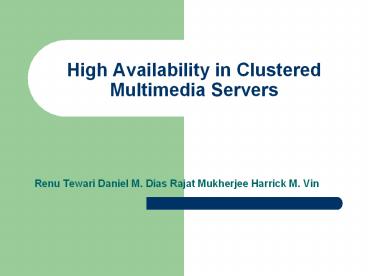High Availability in Clustered Multimedia Servers - PowerPoint PPT Presentation
1 / 19
Title:
High Availability in Clustered Multimedia Servers
Description:
High Availability in Clustered Multimedia Servers Renu Tewari Daniel M. Dias Rajat Mukherjee Harrick M. Vin Topics Problem: high availability in clustered multimedia ... – PowerPoint PPT presentation
Number of Views:67
Avg rating:3.0/5.0
Title: High Availability in Clustered Multimedia Servers
1
High Availability in Clustered Multimedia Servers
- Renu Tewari Daniel M. Dias Rajat Mukherjee
Harrick M. Vin
2
Topics
- Problem high availability in clustered
multimedia servers - Schemes for high availability
- Details of some schemes for high availability
- Simulation
- Cost performance analysis
- Conclusion
3
The problem the author addressed
- High availability in clustered multimedia servers
- Clustered multimedia servers consists of a set of
processing node, each with a local disk array,
connected by a high bandwidth switch or network.
High availability requires the servers can
provide continuous delivery in the presence of
failures, including disk failure and node failure.
4
Architecture of clustered multimedia servers
Front end performs delivery. Back end provides
storage.
5
Architecture of clustered multimedia servers
- Front end fails
- Stream can be resumed from another delivery node.
- Back end fails
- Has system-wide effect. It is the major concern
in this paper.
6
Schemes for high availability
- Mirroring
- Disk level mirroring
- Block level mirroring
7
Schemes for high availability
- Twin-tailing/Multi Tailing
- Used to handle node failure. A buddy node can
access the others disks in case of failure.
8
Schemes for high availability
- Software raid
- Sequential parity placement
- Random parity placement
9
Sequential parity placement
- Disk numbered i, is attached to a node numbered i
mod N, Nnumber of nodes - Parity group, if size5, DDDDPDDDDP
10
Sequential parity placement
11
Sequential parity placement
12
Random parity placement
- Constraint
- Blocks belonging to the same parity group are not
placed on the same disk or on any disk on the
same node.
13
Random parity placement
14
Some simulation results
15
Some simulation results
16
Comparison between spp and rpp
- According to the simulation, RPPs performance is
better than SPP. - RPP needs much more meta-data.
- Increasing the read-ahead buffer size,with RPP,
the loss can be reduced substantially. - To decrease the amount of meta data of RPP, SPP
with multiple strides can be used.
17
Cost analytical model
- Queue theory
- Each disk behaves like an M/D/1 queue.
18
Conclusions
- Sequential placement of parity can only balance
the space and bandwidth utilization of all disks
during normal operation. - Balanced random placement of parity can achieve
during failure and normal operation. - Mirroring is cost effective only when missing the
real time constraints during failure is more
expensive than the extra disk capacity. - Larger parity group sizes have smaller disk space
overhead but larger memory costs for buffering. - Tighter loss criteria require small parity group
size.
19
Questions
- Name 3 schemes for high availability.
- In sequential parity placement, why should you
choose the parity group size to be relatively
prime to the number of disks?































